Integrated Design Project: Liverpool Hotel Building Design
VerifiedAdded on 2020/10/05
|7
|1079
|142
Project
AI Summary
This document is a project report detailing the design of a 10-story hotel building proposed for construction in Liverpool, specifically at an old dock site. It encompasses various aspects of the project, starting with a brief introduction and design specifications, which include site location, council proposals, aesthetics, building functionality, preliminary design investigations, and construction methods. The report further delves into design economics, particularly life cycle cost analysis, followed by a business plan outlining site requirements, schedules, delivery methods, and risk assessments. Environmental impact and sustainability considerations are also addressed, highlighting the project's approach to minimizing pollution and maximizing the use of recycled materials. The conclusion summarizes the key concepts and techniques discussed, emphasizing the design team's commitment to meeting client needs. References to relevant literature are also included.
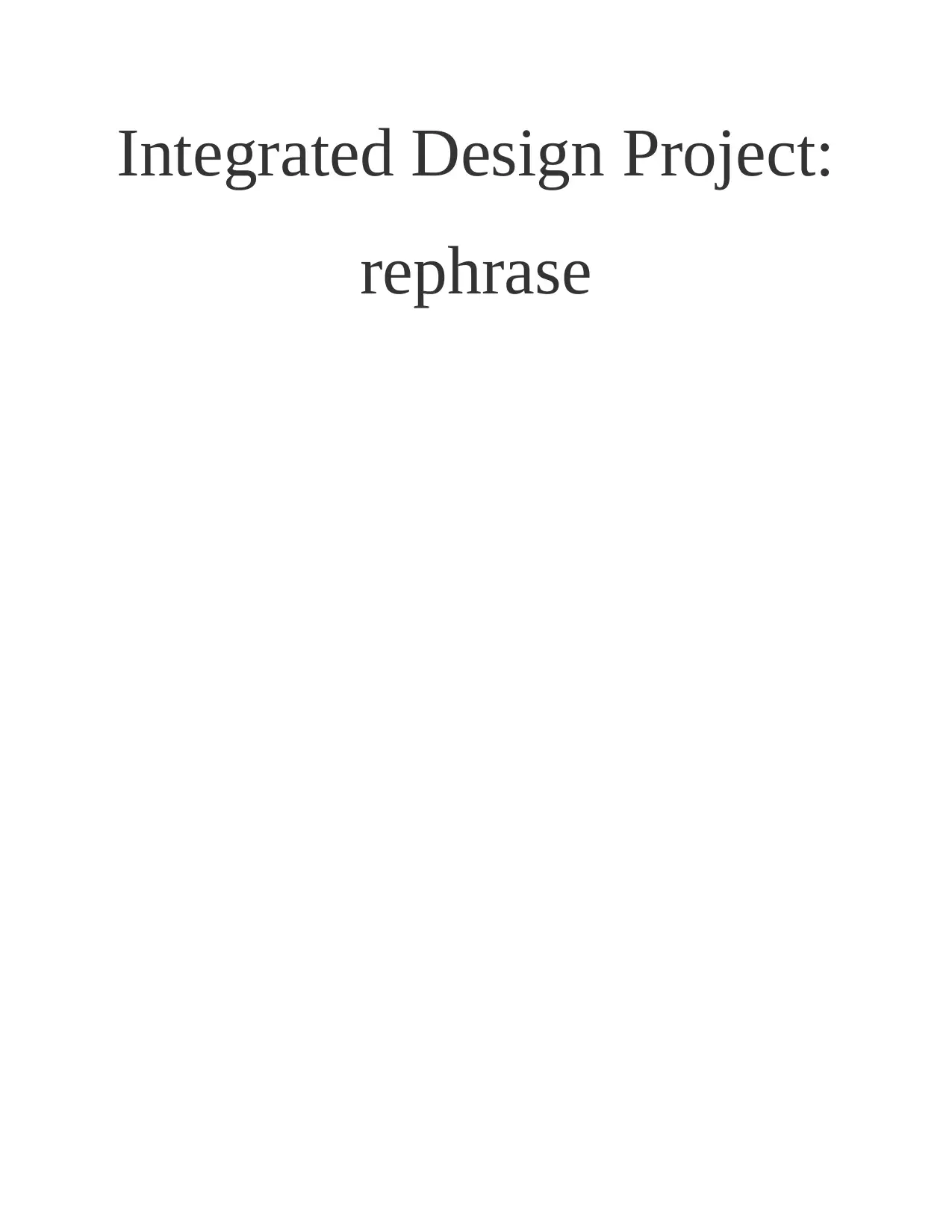
Integrated Design Project:
rephrase
rephrase
Paraphrase This Document
Need a fresh take? Get an instant paraphrase of this document with our AI Paraphraser
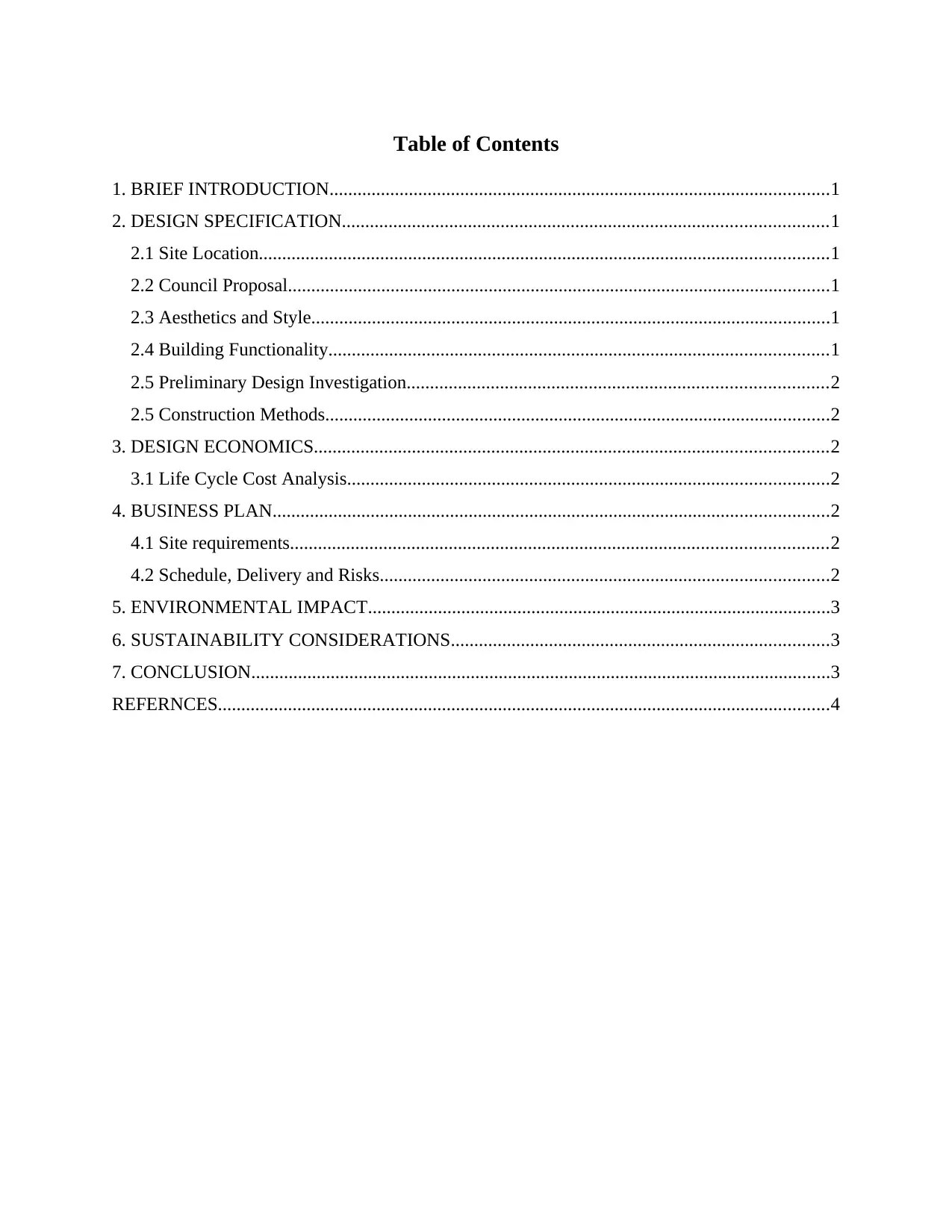
Table of Contents
1. BRIEF INTRODUCTION...........................................................................................................1
2. DESIGN SPECIFICATION........................................................................................................1
2.1 Site Location..........................................................................................................................1
2.2 Council Proposal....................................................................................................................1
2.3 Aesthetics and Style...............................................................................................................1
2.4 Building Functionality...........................................................................................................1
2.5 Preliminary Design Investigation..........................................................................................2
2.5 Construction Methods............................................................................................................2
3. DESIGN ECONOMICS..............................................................................................................2
3.1 Life Cycle Cost Analysis.......................................................................................................2
4. BUSINESS PLAN.......................................................................................................................2
4.1 Site requirements...................................................................................................................2
4.2 Schedule, Delivery and Risks................................................................................................2
5. ENVIRONMENTAL IMPACT...................................................................................................3
6. SUSTAINABILITY CONSIDERATIONS.................................................................................3
7. CONCLUSION............................................................................................................................3
REFERNCES...................................................................................................................................4
1. BRIEF INTRODUCTION...........................................................................................................1
2. DESIGN SPECIFICATION........................................................................................................1
2.1 Site Location..........................................................................................................................1
2.2 Council Proposal....................................................................................................................1
2.3 Aesthetics and Style...............................................................................................................1
2.4 Building Functionality...........................................................................................................1
2.5 Preliminary Design Investigation..........................................................................................2
2.5 Construction Methods............................................................................................................2
3. DESIGN ECONOMICS..............................................................................................................2
3.1 Life Cycle Cost Analysis.......................................................................................................2
4. BUSINESS PLAN.......................................................................................................................2
4.1 Site requirements...................................................................................................................2
4.2 Schedule, Delivery and Risks................................................................................................2
5. ENVIRONMENTAL IMPACT...................................................................................................3
6. SUSTAINABILITY CONSIDERATIONS.................................................................................3
7. CONCLUSION............................................................................................................................3
REFERNCES...................................................................................................................................4

⊘ This is a preview!⊘
Do you want full access?
Subscribe today to unlock all pages.

Trusted by 1+ million students worldwide
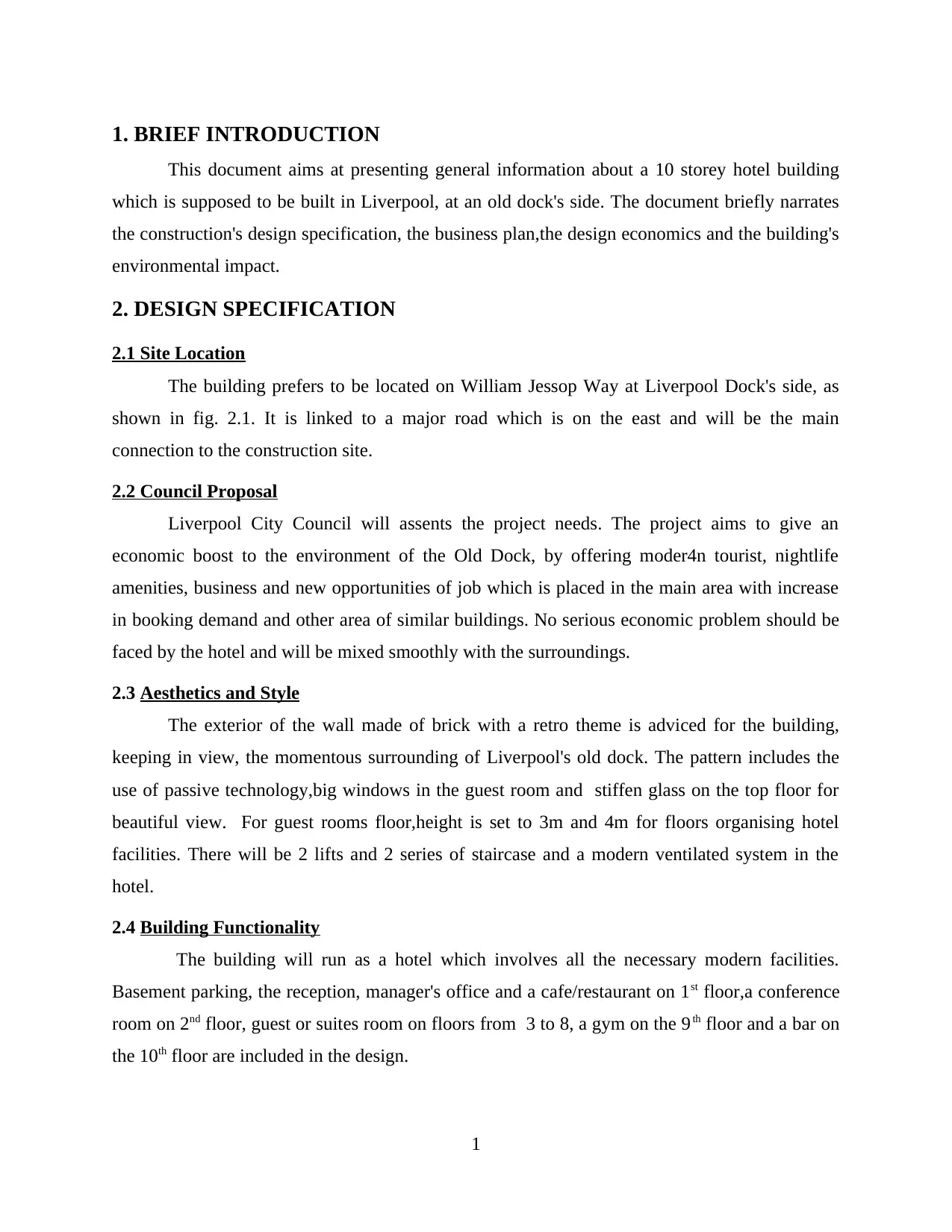
1. BRIEF INTRODUCTION
This document aims at presenting general information about a 10 storey hotel building
which is supposed to be built in Liverpool, at an old dock's side. The document briefly narrates
the construction's design specification, the business plan,the design economics and the building's
environmental impact.
2. DESIGN SPECIFICATION
2.1 Site Location
The building prefers to be located on William Jessop Way at Liverpool Dock's side, as
shown in fig. 2.1. It is linked to a major road which is on the east and will be the main
connection to the construction site.
2.2 Council Proposal
Liverpool City Council will assents the project needs. The project aims to give an
economic boost to the environment of the Old Dock, by offering moder4n tourist, nightlife
amenities, business and new opportunities of job which is placed in the main area with increase
in booking demand and other area of similar buildings. No serious economic problem should be
faced by the hotel and will be mixed smoothly with the surroundings.
2.3 Aesthetics and Style
The exterior of the wall made of brick with a retro theme is adviced for the building,
keeping in view, the momentous surrounding of Liverpool's old dock. The pattern includes the
use of passive technology,big windows in the guest room and stiffen glass on the top floor for
beautiful view. For guest rooms floor,height is set to 3m and 4m for floors organising hotel
facilities. There will be 2 lifts and 2 series of staircase and a modern ventilated system in the
hotel.
2.4 Building Functionality
The building will run as a hotel which involves all the necessary modern facilities.
Basement parking, the reception, manager's office and a cafe/restaurant on 1st floor,a conference
room on 2nd floor, guest or suites room on floors from 3 to 8, a gym on the 9th floor and a bar on
the 10th floor are included in the design.
1
This document aims at presenting general information about a 10 storey hotel building
which is supposed to be built in Liverpool, at an old dock's side. The document briefly narrates
the construction's design specification, the business plan,the design economics and the building's
environmental impact.
2. DESIGN SPECIFICATION
2.1 Site Location
The building prefers to be located on William Jessop Way at Liverpool Dock's side, as
shown in fig. 2.1. It is linked to a major road which is on the east and will be the main
connection to the construction site.
2.2 Council Proposal
Liverpool City Council will assents the project needs. The project aims to give an
economic boost to the environment of the Old Dock, by offering moder4n tourist, nightlife
amenities, business and new opportunities of job which is placed in the main area with increase
in booking demand and other area of similar buildings. No serious economic problem should be
faced by the hotel and will be mixed smoothly with the surroundings.
2.3 Aesthetics and Style
The exterior of the wall made of brick with a retro theme is adviced for the building,
keeping in view, the momentous surrounding of Liverpool's old dock. The pattern includes the
use of passive technology,big windows in the guest room and stiffen glass on the top floor for
beautiful view. For guest rooms floor,height is set to 3m and 4m for floors organising hotel
facilities. There will be 2 lifts and 2 series of staircase and a modern ventilated system in the
hotel.
2.4 Building Functionality
The building will run as a hotel which involves all the necessary modern facilities.
Basement parking, the reception, manager's office and a cafe/restaurant on 1st floor,a conference
room on 2nd floor, guest or suites room on floors from 3 to 8, a gym on the 9th floor and a bar on
the 10th floor are included in the design.
1
Paraphrase This Document
Need a fresh take? Get an instant paraphrase of this document with our AI Paraphraser
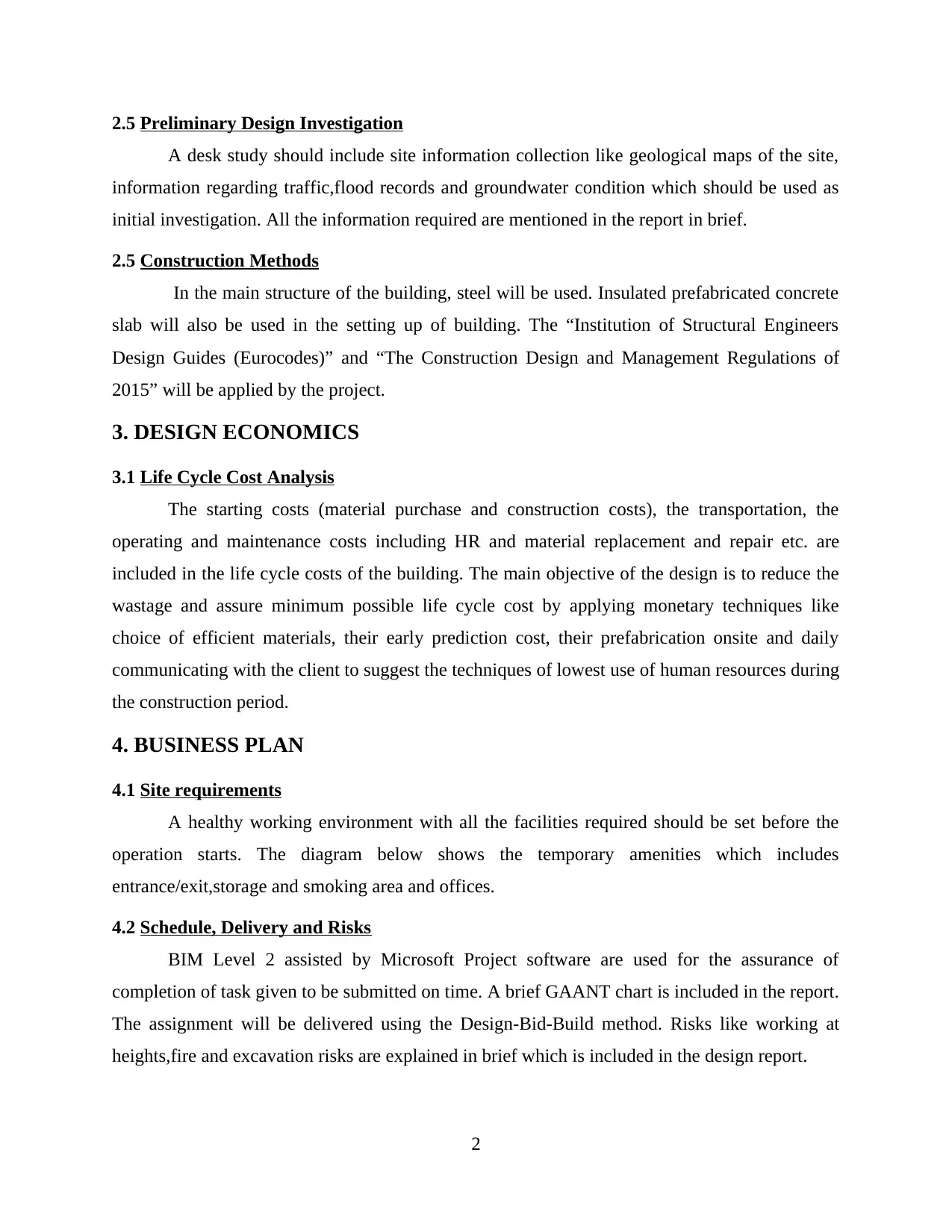
2.5 Preliminary Design Investigation
A desk study should include site information collection like geological maps of the site,
information regarding traffic,flood records and groundwater condition which should be used as
initial investigation. All the information required are mentioned in the report in brief.
2.5 Construction Methods
In the main structure of the building, steel will be used. Insulated prefabricated concrete
slab will also be used in the setting up of building. The “Institution of Structural Engineers
Design Guides (Eurocodes)” and “The Construction Design and Management Regulations of
2015” will be applied by the project.
3. DESIGN ECONOMICS
3.1 Life Cycle Cost Analysis
The starting costs (material purchase and construction costs), the transportation, the
operating and maintenance costs including HR and material replacement and repair etc. are
included in the life cycle costs of the building. The main objective of the design is to reduce the
wastage and assure minimum possible life cycle cost by applying monetary techniques like
choice of efficient materials, their early prediction cost, their prefabrication onsite and daily
communicating with the client to suggest the techniques of lowest use of human resources during
the construction period.
4. BUSINESS PLAN
4.1 Site requirements
A healthy working environment with all the facilities required should be set before the
operation starts. The diagram below shows the temporary amenities which includes
entrance/exit,storage and smoking area and offices.
4.2 Schedule, Delivery and Risks
BIM Level 2 assisted by Microsoft Project software are used for the assurance of
completion of task given to be submitted on time. A brief GAANT chart is included in the report.
The assignment will be delivered using the Design-Bid-Build method. Risks like working at
heights,fire and excavation risks are explained in brief which is included in the design report.
2
A desk study should include site information collection like geological maps of the site,
information regarding traffic,flood records and groundwater condition which should be used as
initial investigation. All the information required are mentioned in the report in brief.
2.5 Construction Methods
In the main structure of the building, steel will be used. Insulated prefabricated concrete
slab will also be used in the setting up of building. The “Institution of Structural Engineers
Design Guides (Eurocodes)” and “The Construction Design and Management Regulations of
2015” will be applied by the project.
3. DESIGN ECONOMICS
3.1 Life Cycle Cost Analysis
The starting costs (material purchase and construction costs), the transportation, the
operating and maintenance costs including HR and material replacement and repair etc. are
included in the life cycle costs of the building. The main objective of the design is to reduce the
wastage and assure minimum possible life cycle cost by applying monetary techniques like
choice of efficient materials, their early prediction cost, their prefabrication onsite and daily
communicating with the client to suggest the techniques of lowest use of human resources during
the construction period.
4. BUSINESS PLAN
4.1 Site requirements
A healthy working environment with all the facilities required should be set before the
operation starts. The diagram below shows the temporary amenities which includes
entrance/exit,storage and smoking area and offices.
4.2 Schedule, Delivery and Risks
BIM Level 2 assisted by Microsoft Project software are used for the assurance of
completion of task given to be submitted on time. A brief GAANT chart is included in the report.
The assignment will be delivered using the Design-Bid-Build method. Risks like working at
heights,fire and excavation risks are explained in brief which is included in the design report.
2
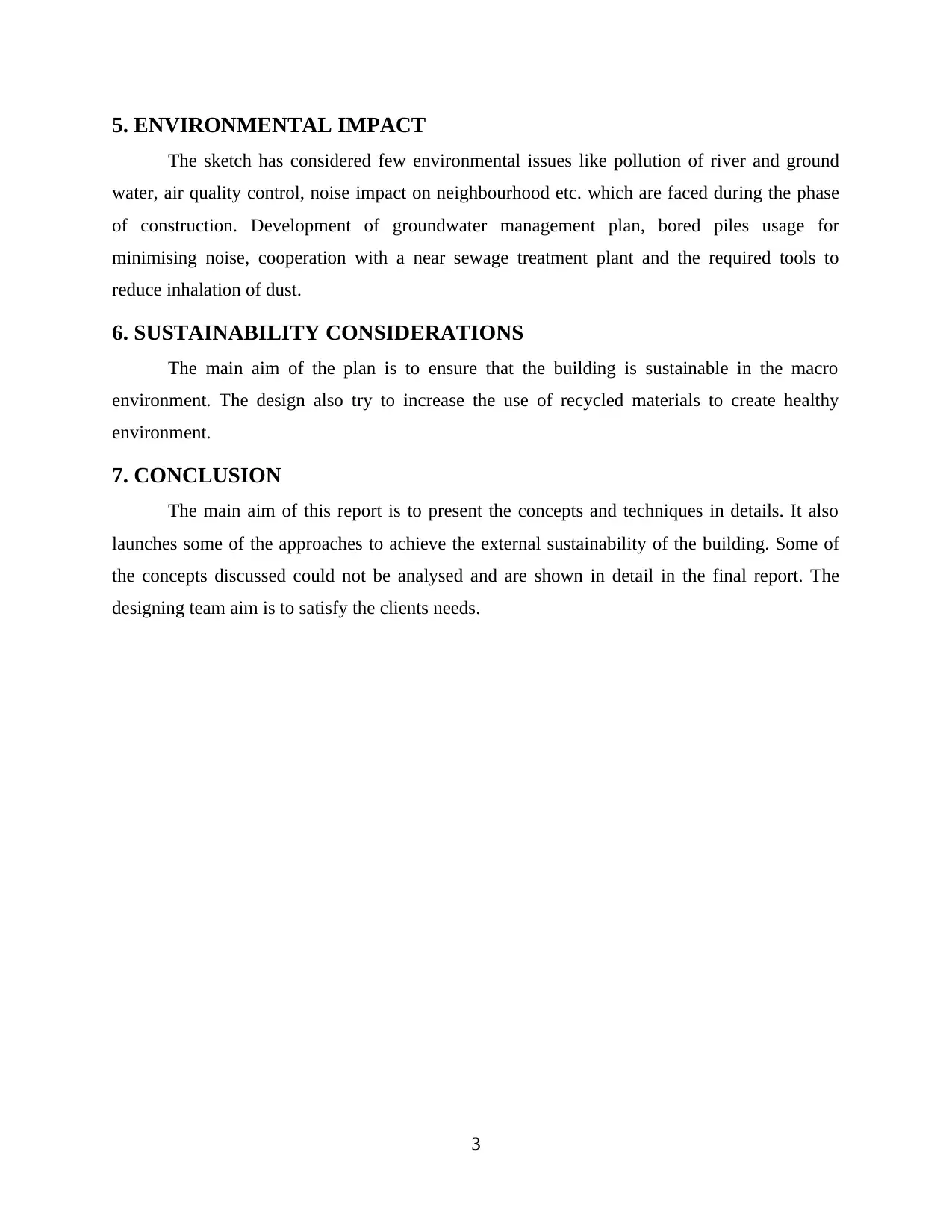
5. ENVIRONMENTAL IMPACT
The sketch has considered few environmental issues like pollution of river and ground
water, air quality control, noise impact on neighbourhood etc. which are faced during the phase
of construction. Development of groundwater management plan, bored piles usage for
minimising noise, cooperation with a near sewage treatment plant and the required tools to
reduce inhalation of dust.
6. SUSTAINABILITY CONSIDERATIONS
The main aim of the plan is to ensure that the building is sustainable in the macro
environment. The design also try to increase the use of recycled materials to create healthy
environment.
7. CONCLUSION
The main aim of this report is to present the concepts and techniques in details. It also
launches some of the approaches to achieve the external sustainability of the building. Some of
the concepts discussed could not be analysed and are shown in detail in the final report. The
designing team aim is to satisfy the clients needs.
3
The sketch has considered few environmental issues like pollution of river and ground
water, air quality control, noise impact on neighbourhood etc. which are faced during the phase
of construction. Development of groundwater management plan, bored piles usage for
minimising noise, cooperation with a near sewage treatment plant and the required tools to
reduce inhalation of dust.
6. SUSTAINABILITY CONSIDERATIONS
The main aim of the plan is to ensure that the building is sustainable in the macro
environment. The design also try to increase the use of recycled materials to create healthy
environment.
7. CONCLUSION
The main aim of this report is to present the concepts and techniques in details. It also
launches some of the approaches to achieve the external sustainability of the building. Some of
the concepts discussed could not be analysed and are shown in detail in the final report. The
designing team aim is to satisfy the clients needs.
3
⊘ This is a preview!⊘
Do you want full access?
Subscribe today to unlock all pages.

Trusted by 1+ million students worldwide
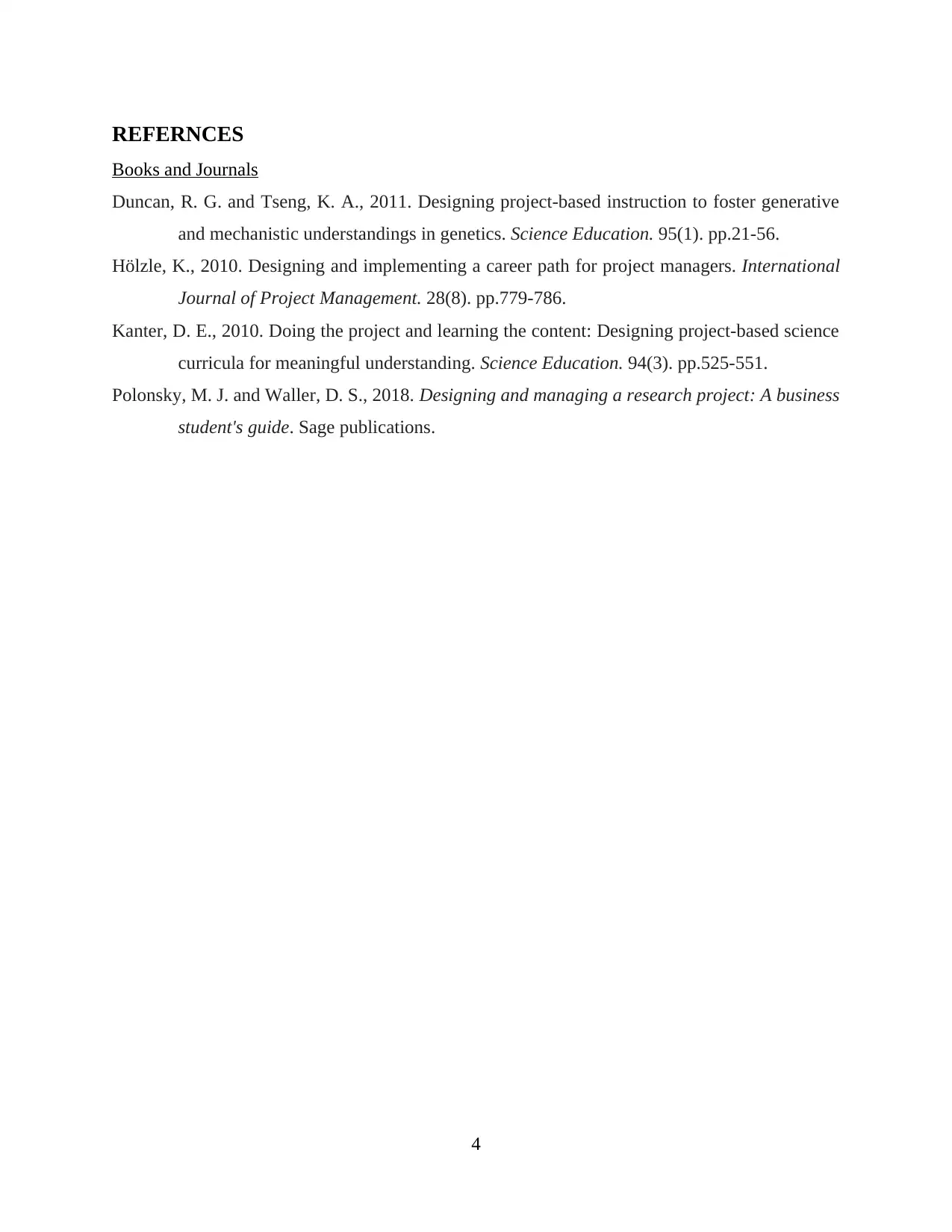
REFERNCES
Books and Journals
Duncan, R. G. and Tseng, K. A., 2011. Designing project‐based instruction to foster generative
and mechanistic understandings in genetics. Science Education. 95(1). pp.21-56.
Hölzle, K., 2010. Designing and implementing a career path for project managers. International
Journal of Project Management. 28(8). pp.779-786.
Kanter, D. E., 2010. Doing the project and learning the content: Designing project‐based science
curricula for meaningful understanding. Science Education. 94(3). pp.525-551.
Polonsky, M. J. and Waller, D. S., 2018. Designing and managing a research project: A business
student's guide. Sage publications.
4
Books and Journals
Duncan, R. G. and Tseng, K. A., 2011. Designing project‐based instruction to foster generative
and mechanistic understandings in genetics. Science Education. 95(1). pp.21-56.
Hölzle, K., 2010. Designing and implementing a career path for project managers. International
Journal of Project Management. 28(8). pp.779-786.
Kanter, D. E., 2010. Doing the project and learning the content: Designing project‐based science
curricula for meaningful understanding. Science Education. 94(3). pp.525-551.
Polonsky, M. J. and Waller, D. S., 2018. Designing and managing a research project: A business
student's guide. Sage publications.
4
1 out of 7
Related Documents
Your All-in-One AI-Powered Toolkit for Academic Success.
+13062052269
info@desklib.com
Available 24*7 on WhatsApp / Email
![[object Object]](/_next/static/media/star-bottom.7253800d.svg)
Unlock your academic potential
Copyright © 2020–2025 A2Z Services. All Rights Reserved. Developed and managed by ZUCOL.





